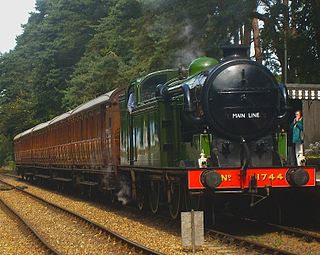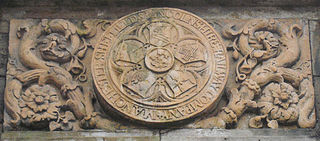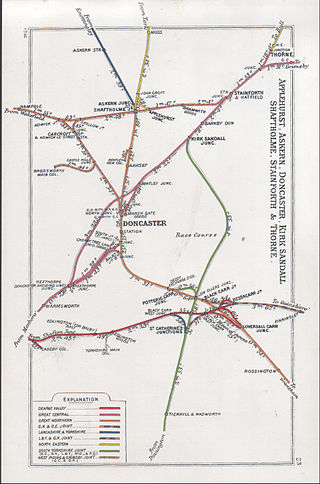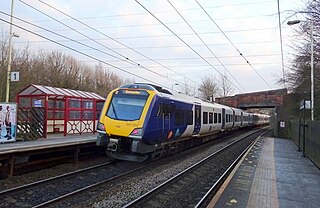The London and North Eastern Railway (LNER) was formed out of a number of constituent railway companies at the grouping in 1923.
The London and North Eastern Railway (LNER) was formed out of a number of constituent railway companies at the grouping in 1923.
The main companies, showing their route mileage, were:
Many of these "railways" existed only in name; they were included on the list at the time of the Railways Act in order to legally qualify each line's position.

The North Norfolk Railway (NNR) – also known as the "Poppy Line" – is a 5+1⁄4-mile (8.4 km) heritage steam railway in Norfolk, England, running between the towns of Sheringham and Holt. The North Norfolk Railway is owned and operated as a public limited company, originally called Central Norfolk Enterprises Limited. The railway is listed as exempt from the UK Railways (Interoperability) Regulations 2000.

The Great Central Railway in England was formed when the Manchester, Sheffield and Lincolnshire Railway changed its name in 1897, anticipating the opening in 1899 of its London Extension. On 1 January 1923, the company was grouped into the London and North Eastern Railway.

The Manchester, Sheffield and Lincolnshire Railway (MS&LR) was formed in 1847 when the Sheffield, Ashton-under-Lyne and Manchester Railway joined with authorised but unbuilt railway companies, forming a proposed network from Manchester to Grimsby. It pursued a policy of expanding its area of influence, especially in reaching west to Liverpool, which it ultimately did through the medium of the Cheshire Lines Committee network in joint partnership with the Great Northern Railway and the Midland Railway.

The South Yorkshire Joint Railway was a committee formed in 1903, between the Great Central Railway, the Great Northern Railway, the Lancashire and Yorkshire Railway, the Midland Railway and the North Eastern Railway to oversee the construction of a new railway in the Doncaster area of South Yorkshire, England. The five companies had equal rights over the line, each of the companies regularly working trains over it.

The Cheshire Lines Committee (CLC) was formed in the 1860s and became the second-largest joint railway in Great Britain. The committee, which was often styled the Cheshire Lines Railway, operated 143 miles (230 km) of track in the then counties of Lancashire and Cheshire. The railway did not become part of the Big Four during the implementation of the 1923 grouping, surviving independently with its own management until the railways were nationalised at the beginning of 1948. The railway served Liverpool, Manchester, Stockport, Warrington, Widnes, Northwich, Winsford, Knutsford, Chester and Southport with connections to many other railways.

The Hallam Line is a railway connecting Leeds and Sheffield via Castleford in the West Yorkshire Metro area of northern England. It is a slower route from Leeds to Sheffield than the Wakefield line. Services on this line are operated by Northern Trains. Services from Leeds to Nottingham also use the line.

The Wakefield line is a railway line and service in the West Yorkshire Metro and South Yorkshire Passenger Transport Executive areas of northern England. The Wakefield line is coloured yellow on maps and publications by West Yorkshire Metro. The line was electrified in 1989, between Leeds & Wakefield Westgate, as part of the programme to electrify the East Coast Main Line.

A joint railway is a railway operating under the control of more than one railway company: those companies very often supplying the traction over the railway.

The Mid-Cheshire line is a railway line in the north-west of England that runs from Chester to Edgeley Junction, Stockport; it connects Chester with Manchester Piccadilly, via Knutsford. After Chester Northgate closed in 1969, the section between Mickle Trafford Junction and Chester was used for freight trains only until it closed in 1992; from Mickle Trafford, passenger trains use the Chester–Warrington line to Chester General instead. The route taken by passenger trains has changed over the years and now differs considerably from the original. Between 2001 and 2014, passenger journeys on the line increased to over 1.7 million per year. A near doubling of the passenger service was expected to occur from December 2018, however this did not materialise.

The Great Central Main Line (GCML), also known as the London Extension of the Manchester, Sheffield and Lincolnshire Railway (MS&LR), is a former railway line in the United Kingdom. The line was opened in 1899 and built by the Great Central Railway running from Sheffield in the North of England, southwards through Nottingham and Leicester to Marylebone in London.

The history of rail transport in Great Britain 1830–1922 covers the period between the opening of the Liverpool and Manchester Railway (L&MR), and the Grouping, the amalgamation of almost all of Britain's many railway companies into the Big Four by the Railways Act 1921.

The York and North Midland Railway (Y&NMR) was an English railway company that opened in 1839 connecting York with the Leeds and Selby Railway, and in 1840 extended this line to meet the North Midland Railway at Normanton near Leeds. Its first chairman was the railway financier George Hudson, who had been called the railway king.

The Otley and Ilkley Joint Railway was a railway line running between the towns of Otley and Ilkley in West Yorkshire. The line was managed and run jointly by the Midland Railway (MR) and the North Eastern Railway (NER) and was 6+1⁄2 miles (10 km) long. Opened to passenger traffic on 1 August 1865 and freight traffic some months later, the line ran for almost 100 years before partial closure in July 1965 when the line to Otley closed. Today passenger services run over the rest of the line as part of the West Yorkshire Passenger Transport Executive (WYPTE) Wharfedale Line.

The Nottingham Suburban Railway was a British railway company that constructed a line 3.65 miles (5.87 km) in length serving the north-eastern suburbs of Nottingham. It was built to shorten the distance by train to Ilkeston and towns on the Leen Valley railway line, and to connect important brickworks near Nottingham. The short line was expensive to build due to difficult topography; it opened in December 1889, and was worked by the Great Northern Railway; the trains used that company's Nottingham terminus.
The Great Northern Railway developed an extensive network over time, having started in 1846 with the intention of connecting London and York, as well as other major Yorkshire towns. The Great Northern Railway in Yorkshire was a major part of that, although the GNR did not succeed in reaching York as it originally intended. By acquiring running powers it reached Leeds, Bradford and Halifax over other companies' lines, as well as Barnsley Sheffield and Grimsby, and then York too. After acquiring local companies it developed a network, chiefly in West Yorkshire. Later it built lines north and west of Bradford into hilly terrain, and these were very expensive to build, and never repaid the initial cost.
The Leen Valley lines of the Great Northern Railway were railway branch lines built to access the collieries in the Nottinghamshire coalfield in England. The Midland Railway had long been dominant in the area, but there was resentment against its monopolistic policies from coalowners, who encouraged the Great Northern Railway to build a line. The Leen Valley Line was opened in 1881; it ran as far as Annesley colliery. A passenger service was run the following year, and very considerable volumes of coal were hauled.